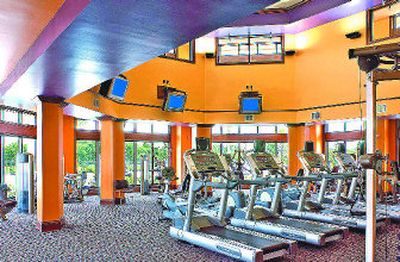Builders developing homes for a different kind of senior

The “New American Home 2007” was unveiled in February at the International Builders Show in Orlando, Fla., to showcase the latest in home design and technology. The ultramodern three-level home comes with a wheelchair ramp and an elevator. There are two bedrooms on the ground floor, each providing a full bath — one with a shower, the other a tub — equipped with a sliding door.
Those design features cater to one of the most powerful trends in the housing industry: Americans ages 55 and older will buy one in every five new homes this year — $103 billion worth — according to research by the National Association of Home Builders.
About 7 percent of those new homes will be bought in communities designed for the 55-plus crowd. That’s a small but growing proportion, and one that few developers can afford to ignore. Homebuilders will start construction on 145,000 homes in 55-plus communities this year, the NAHB estimates.
Though they tend to be wealthier than younger age groups, many of those nearing retirement say they worry about outliving their savings. They’re more active and health-conscious than generations past. And they’re working into their sunset years, often in second careers. Those trends are transforming the styles of homes and retirement communities that developers are creating.
“Budding retirees — they’re really faced with planning for very long periods of time, and in a time of financial uncertainty,” says Dave Schreiner, a vice president for Pulte Homes. With the shaky stock market and low interest rates on savings accounts, he says, “Imagine being a 55-year-old person, thinking about the next 40 years in some pretty daunting circumstances.”
That’s especially true for folks with scant resources to fall back on. More than one-third of people 55 and older earn less than $25,000, and nearly one-fourth have household net worth under $50,000. If these people move, they typically go into age-restricted or assisted-living apartments, which are cheaper than having a mortgage payment and are sometimes government-subsidized.
But the real estate boom also gave a boost to people in that age group who already owned homes. For that reason, half the buyers in age-restricted communities didn’t need to take out a mortgage because they made so much money on the sale of their previous homes, according to the NAHB research.
In fact, a big home equity cushion is one reason why many retirees don’t want to move at all. The New Yorkers who move to Florida, or Californians who migrate to Arizona, make up a minority of retirees. Only 5 percent of people over 55 move in any given year, and of those, half stay in the same county and three-fourths in the same state, according to government data.
“A lot of these people already own their homes, without much debt and they’re pretty happy with them,” says Paul Emrath of the NAHB. “To attract them, you have to offer something really good.”
The trick is to offer features for aging buyers that don’t make them feel, well, old.
“None of them think they’re old or are ever going to be old,” Emrath says. “That tendency is not changing (with baby boomers). If anything, it’s stronger than ever. That leads to clever sorts of marketing.”
One builder designed the hallways and doorways wider for residents who might someday need a walker or wheelchair, he recalls, but the builder told prospective buyers that the halls and doors were designed to make it easier to get an expensive desk in the room.
Nearly 30 percent of people ages 55 to 64 reported having some physical difficulty, according to the 2005 American Community Survey by the U.S. Census. Emrath said he was surprised by how many people continued to live in single-family homes despite physical troubles, such as hearing or vision loss.
Nevertheless, many retirees are far more active than in decades past. Pulte Homes has started adding river rafting, recreational flying and even skydiving to the activities at its Del Webb-brand retirement communities. More than 90 percent of new homebuyers in 55-plus communities have access to recreational facilities, according to the NAHB.
Activity planners in retirement areas are also finding they have to offer more events in the evenings and on weekends because more residents are working past the typical retirement age, a trend that is expected to continue. That’s made the home office a standard feature in many retirement homes. The latest trend, Schreiner says, is his-and-her offices. “Twenty years ago,” he says, “about 80 percent of our homes had two bedrooms. Today, about 80 percent of them have three bedrooms.” The third bedroom is often turned into an office.
Some retirement communities are being built closer to urban areas to allow residents to remain connected to the labor force and other businesses. The “New American Home 2007” has an office on the first floor, and the theater room could double as a space for meeting and entertaining clients.
The dominant reason for choosing a new home is the room layout and design, according to the NAHB. Architects say the designs of most new homes are more open, with the kitchen often a focal point.
“It’s indicative of where we’re going — an open lifestyle, not enclosing it into a formal dining room or living room. Just fun,” says Ron Nowfel, an architect at Robb & Stucky Interiors.
Which is what many members of the 55-plus crowd are looking for in retirement —fun, with some work on the side.